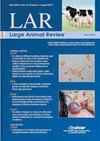Blood and carcass characteristics of two chicken strains subjected to Ocimum graticimum leaf based diet as substitute for synthetic antibiotics
IF 0.3
4区 农林科学
Q4 AGRICULTURE, DAIRY & ANIMAL SCIENCE
引用次数: 0
Abstract
This study was designed to evaluate the effect of graded levels of scent leaf meals on blood parameters and carcass characteristics among two broiler strains. A total of 150 unsexed broilers consisting of 75 Abor Acre and 75 Cobb were randomly allotted into 5 treatments of 15 birds for each strain. Treatment one (T1) had no scent leaf meal (control); treatment two (T2), treatment three (T3), treatment four (T4) and treatment five (T5) had 0.5%, 1.0%, 1.5%, and 2.0% throughout the experimental period (56days). Blood samples and carcass characteristics were evaluated after the feeding trial and subjected to analysis of variance in a completely randomized design. Results revealed that diets and strain significantly (P < 0.05) affected live weight, dressed weights, and dressing percentages. T3 had the highest live and dressed weight (2091.50 ± 85.27 g and 1737.67 ± 22.16 g), while T5 recorded the lowest (1700 ± 102.47 g and1253.17 ± 68.09 g). Cobb was superior to Arbor acre for all carcass traits except for leg weight. Red Blood Cell, White Blood Cell, Mean Corpuscular Volume, Mean Corpuscular Haemoglobin and Mean Corpuscular Haemoglobin Count of the two strains were significantly (P < 0.05) different, while Pack Cell Volume, Haemoglobin, Neutrophils, Lymphocytes, Monocytes, Eosinphils and Basophils were not significantly different (P > 0.05). This study revealed no detrimental effect of the test ingredients on birds, though 1.5% inclusion rate could be tolerated, 1.0% is recommended for optimum performance, and can therefore efficiently replace synthetic antibiotic in broiler production.以枸杞叶为基础饲粮替代合成抗生素对2个鸡品系血液和胴体特性的影响
本试验旨在评价不同水平香叶饲粮对2个肉鸡品系血液参数和胴体特性的影响。选取75只Abor Acre和75只Cobb的无性肉鸡150只,随机分为5个处理,每个处理15只。处理1 (T1)无香味叶粉(对照);处理2 (T2)、处理3 (T3)、处理4 (T4)、处理5 (T5)试验期(56d)分别为0.5%、1.0%、1.5%、2.0%。饲喂试验结束后对血液样本和胴体特征进行评估,并采用完全随机设计进行方差分析。结果表明,饲粮和应变对活重、屠宰重和屠宰率有显著影响(P < 0.05)。T3的活重和屠宰重最高,分别为2091.50±85.27 g和1737.67±22.16 g, T5的最低,分别为1700±102.47 g和1253.17±68.09 g。除腿重外,Cobb的所有胴体性状均优于Arbor acre。两菌株红细胞、白细胞、平均红细胞体积、平均红细胞血红蛋白和平均红细胞血红蛋白计数差异显著(P < 0.05),而包细胞体积、血红蛋白、中性粒细胞、淋巴细胞、单核细胞、嗜酸性粒细胞和嗜碱性粒细胞差异不显著(P < 0.05)。本研究表明,试验成分对肉鸡无不良影响,但1.5%的添加率可耐受,推荐1.0%的添加率可达到最佳性能,可有效替代肉鸡生产中的合成抗生素。
本文章由计算机程序翻译,如有差异,请以英文原文为准。
求助全文
约1分钟内获得全文
求助全文
来源期刊

Large Animal Review
AGRICULTURE, DAIRY & ANIMAL SCIENCE-
CiteScore
0.90
自引率
16.70%
发文量
0
审稿时长
>12 weeks
期刊介绍:
Large Animal Review is a bimonthly magazine published by
SIVAR (Italian Society of Farm Animals Veterinary Practitioners) for
scientific updating of veterinarians who deal with animals in livestock production and the supply chain control in the production
of food industry. The topics of main interest for the journal are
those of internal medicine, surgery, obstetrics, animal nutrition,
zootechnics, infectious and parasitic diseases, food safety and security, animal welfare, prevention and management.
 求助内容:
求助内容: 应助结果提醒方式:
应助结果提醒方式:


